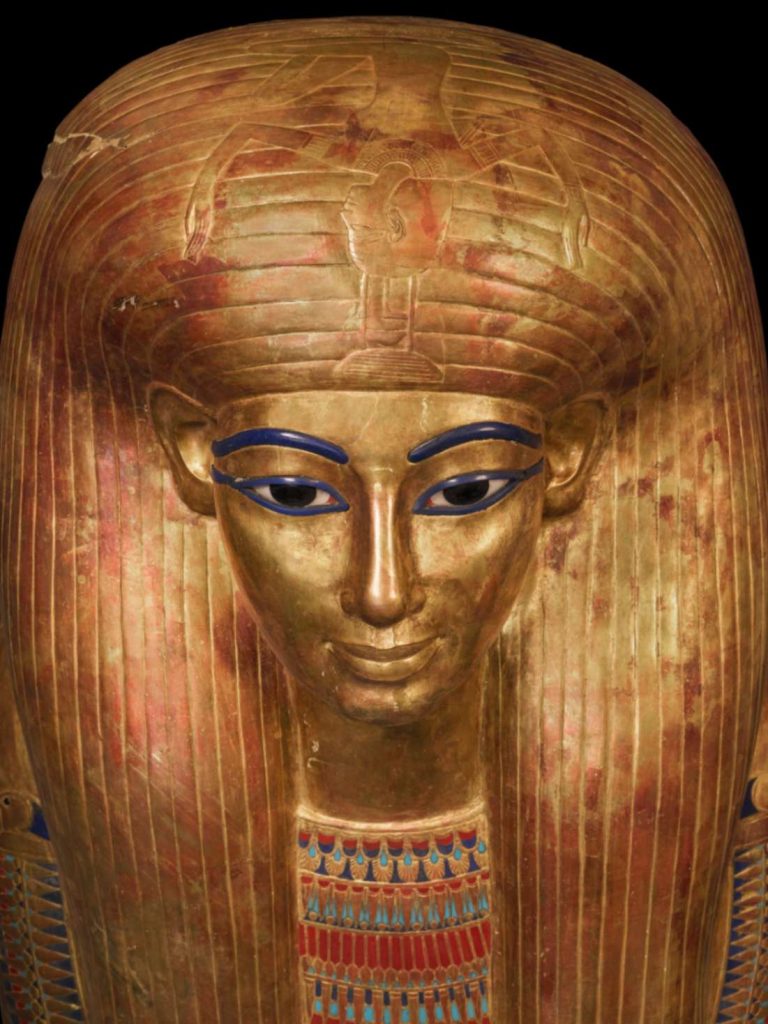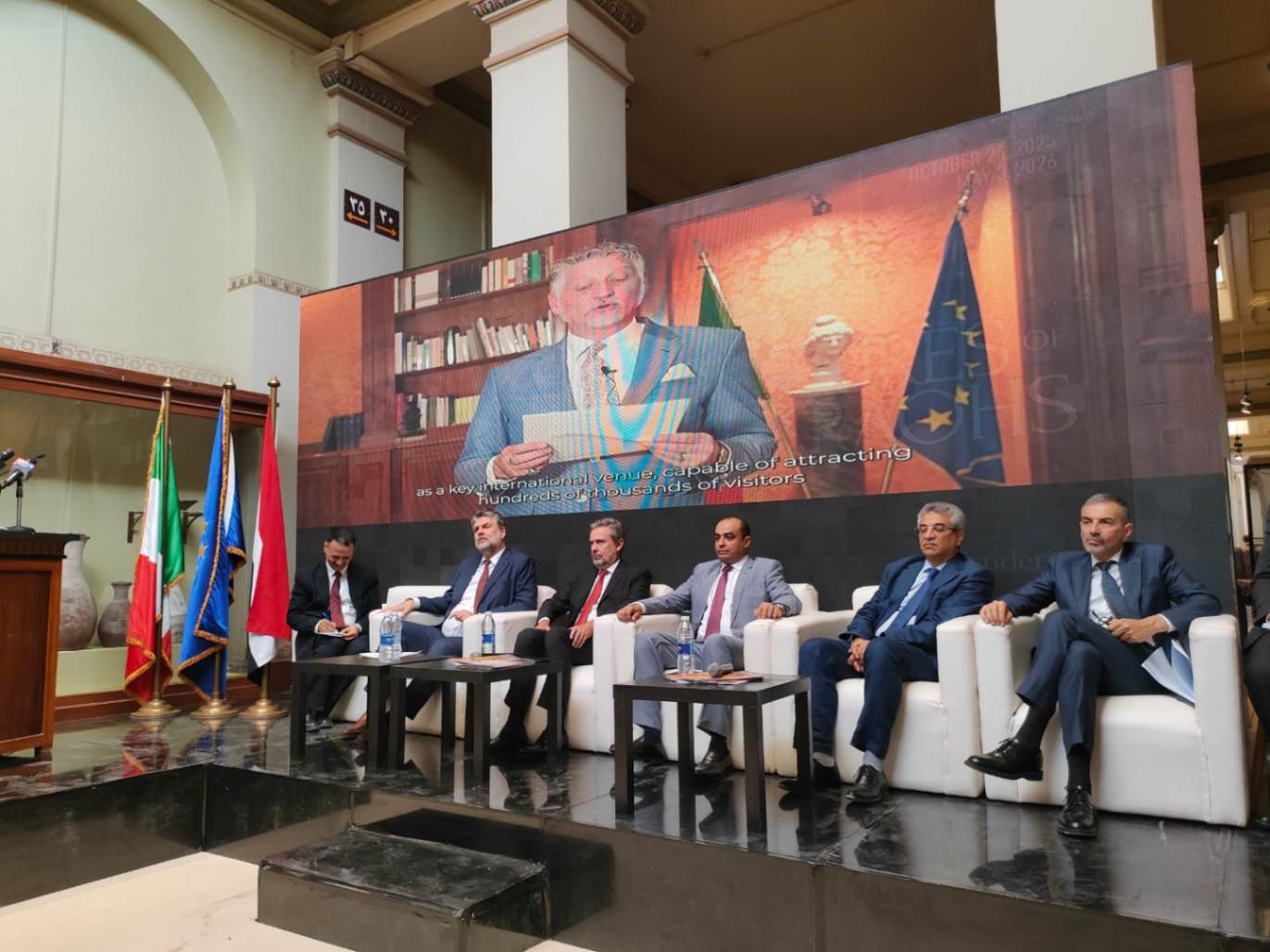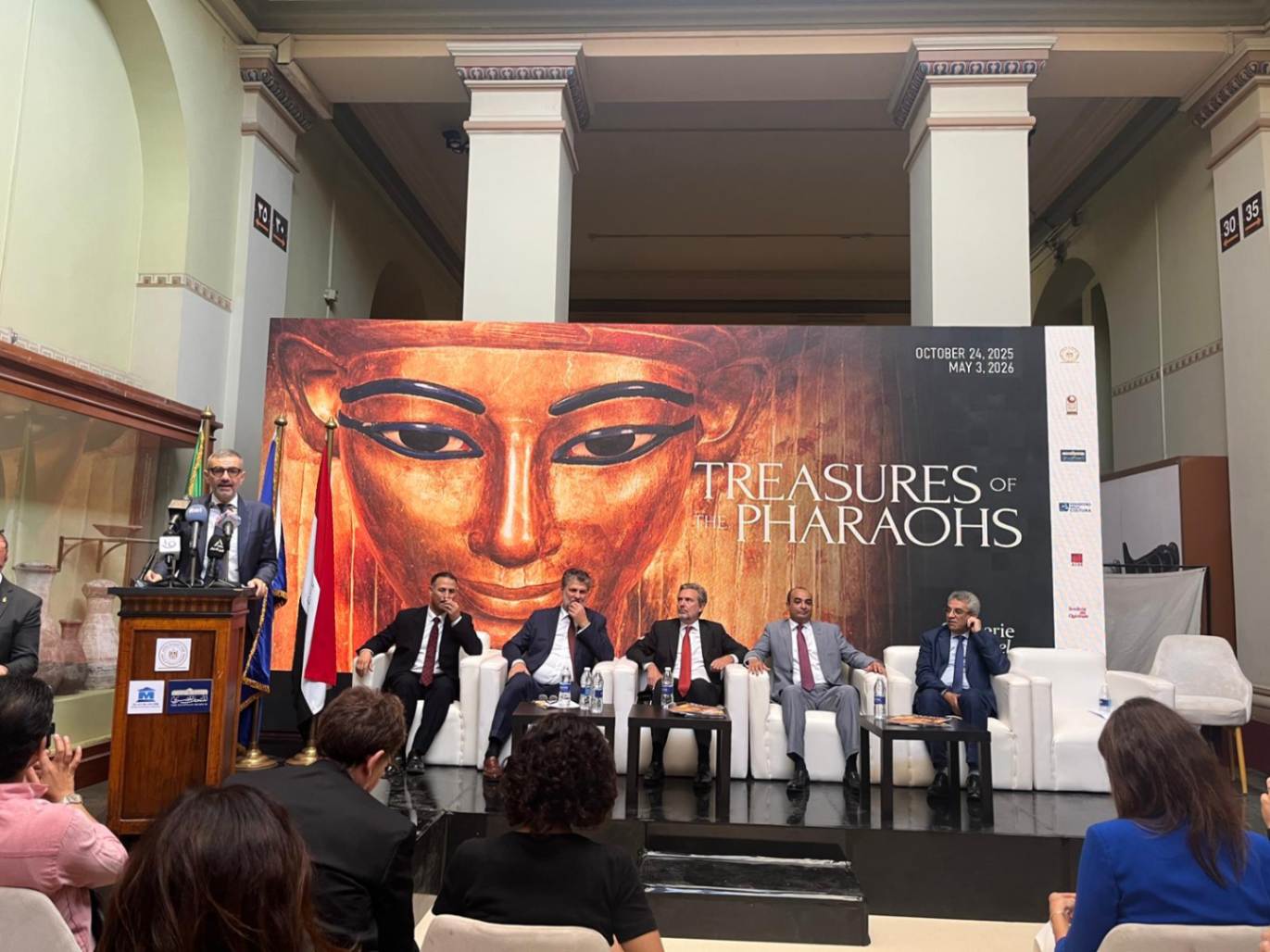TREASURES OF THE PHARAOHS
Ancient Egypt at the Scuderie del Quirinale
24 October 2025 – 3 May 2026
At Scuderie del Quirinale opens Treasures of the Pharaohs, a major cultural project that brings to the Italian capital a selection of 130 masterpieces of ancient Egyptian art from the Egyptian Museum in Cairo and the Luxor Museum, many of which are being exhibited abroad for the first time.
The exhibition, curated by Tarek El Awady, former Director of the Egyptian Museum in Cairo, is produced by ALES – Arte Lavoro e Servizi of the Ministry of Culture together with MondoMostre, in collaboration with the Supreme Council of Antiquities of Egypt, with the support of the Ministry of Foreign Affairs and International Cooperation, the Ministry of Culture, and the Ministry of Tourism and Antiquities of Egypt, under the patronage of the Lazio Region and with the scientific collaboration of the Egyptian Museum of Turin.
Treasures of the Pharaohs is a journey through Egyptian civilization in its most elevated and, at the same time, most intimate dimensions: power, faith, and daily life. The exhibition opens with the splendor of gold, a divine material and symbol of eternity. The gilded sarcophagus of Queen Ahhotep II, the Golden Fly Necklace – an ancient military decoration for valor in battle – and the collar of Psusennes I introduce visitors to the world of the Egyptian elite, where adornment becomes a political language and a reflection of a theology of power. Around the funerary assemblage of Psusennes I, discovered at Tanis in 1940, the exhibition gathers objects of extraordinary refinement: amulets, cups, and jewels that, after three thousand years, still preserve their original radiance.
From royal magnificence, the visitor enters the universe of afterlife, where death was conceived as transformation. The monumental sarcophagus of Tuya, mother of Queen Tiye, dominates a section devoted to funerary practices and the faith in rebirth. Surrounding it are shabti figurines, canopic jars, and a papyrus of the Book of the Dead, illustrating the almost scientific precision with which the ancient Egyptians prepared for the journey to the afterlife – a set of formulas, images, and instruments designed to navigate the invisible world and be reborn in the light of Ra.
The exhibition then opens onto the human face of kingship. The tombs of nobles and officials, such as that of Sennefer, reveal the everyday life of power, devotion, and duty of those who served the pharaoh as guarantors of cosmic order. In dialogue with these figures, the gilded chair of Sitamun, daughter of Amenhotep III, offers a surprising glimpse of intimacy: a domestic object, used in life and then placed as a gift in her grandparents’ tomb, a rare testimony of affection and family continuity.
One of the most anticipated sections is dedicated to the “Golden City” of Amenhotep III, discovered in 2021 by Zahi Hawass. The tools, seals, and amulets from this extraordinary site give voice to the artisans and workers who built the grandeur of the pharaohs. There, among workshops and houses, Egyptian civilization reveals its most human and industrious side, capable of uniting technical mastery and religious meaning in every gesture.
The exhibition culminates in the mystery of divine kingship. The statues and reliefs that conclude the journey represent some of the highest expressions of pharaonic art: the kneeling Hatshepsut in an act of offering, the dyad of Thutmose III with Amun, the Triad of Menkaure, and the splendid gold mask of Amenemope, where the king’s idealized features become the icon of a body transformed into the divine. As a symbolic conclusion, the Mensa Isiaca – exceptionally loaned by the Egyptian Museum of Turin – reconnects the symbolic thread linking Alexandria to Rome, testifying to the ancient spiritual and cultural bond between the two worlds.
As Zahi Hawass reminds us,
“The greatest monument ever built by Egypt was not a pyramid or a temple, but the very idea of eternity.”
It is this idea, stronger than stone and gold, that resonates throughout every hall of the exhibition.
Treasures of the Pharaohs is accompanied by an extensive program of cultural mediation and outreach. The catalog, published by Allemandi in Italian and English editions, is curated by Zahi Hawass, who also authors for the publisher both the short guide and the children’s guide, designed to accompany younger audiences through an accessible and engaging narrative of stories, deities, and symbols of Ancient Egypt. In the catalog, photographs by Massimo Listri convey the magnificence of the exhibited masterpieces and the atmosphere of the Egyptian collections.
Visitors will also be able to enjoy an audioguide included with the ticket, available in four languages, featuring the voice of Roberto Giacobbo for the Italian version and Zahi Hawass for the English version; a special children’s version is also provided, offering an even more engaging visit experience for the youngest.
A comprehensive educational program has also been developed for all audiences. Workshops and guided tours, designed in collaboration with the Egyptian Museum of Turin, take inspiration from the central themes of the exhibition to offer interactive and immersive experiences. Younger visitors, for example, will be able to explore symbols, animals, and divine figures, reconstructing daily life in ancient Egypt through hands-on learning. For schools – from preschool to lower secondary – dedicated workshops are already available, extending traditional educational offerings and allowing students to explore the exhibition’s main themes, including social evolution, funerary art, religious iconography, and material innovation.
Alongside these programs, a series of collateral events is organized in collaboration with the Department of SARAS of the Faculty of Arts at Sapienza University of Rome, featuring meetings, seminars, and lectures by scholars, archaeologists, and experts, aimed at enriching the exhibition experience and fostering dialogue between culture, research, and the public.
On the website www.scuderiequirinale.it, visitors can purchase advance tickets (recommended due to high demand) and download all audioguides free of charge. The website also features the complete schedule of educational workshops, guided tours, and related events.
“This exhibition tells not only the story of the pharaohs but also of the people who surrounded them,” explains curator Tarek El Awady. “Each artifact is a voice that speaks of life, faith, and immortality. It is a dialogue between past and present, between Egypt and Italy, that has continued for three thousand years.”
“Treasures of the Pharaohs,” adds Fabio Tagliaferri, President of ALES, “reaffirms the role of the Scuderie del Quirinale—managed by ALES on behalf of the Ministry of Culture—as a venue devoted to major universal narratives and international cultural cooperation. Through this project, ALES and its institutional partners present a model of cultural collaboration that extends beyond the exhibition itself, encompassing training initiatives, educational programs, academic exchanges, and joint projects with Italian and Egyptian museums and universities. In this way, culture becomes a true infrastructure of relationships, fully aligned with the principles of the Mattei Plan, and a concrete investment in knowledge and in the shared future of the Mediterranean.”
Alessandro Giuli, Italian Minister of Culture:
“This exhibition is the result of a relationship between Italy and Egypt that has its roots in antiquity, flourishes today through dynamic and fruitful cooperation, and is capable of projecting itself into the future.
The Meloni government has included culture and cultural diplomacy initiatives within the framework of the Mattei Plan for Africa as a strategic priority, recognizing the cultural dimension as a fundamental pillar for building peace and stability in the Mediterranean and Africa, and for fostering an integrated development of Eur-Africa, as I like to define our shared continent.
‘Treasures of the Pharaohs’ is an excellent and exemplary expression of this approach. It is not merely an exhibition of magnificent artifacts—symbols of a millennia-old civilization that gave form to the mystery of life through culture and profoundly influenced the most prestigious traditions, both Eastern and Western.
Scuderie del Quirinale, under the management of ALES, stand as an internationally recognized center of excellence, capable of attracting audiences from around the world. The scientific rigor, the quality of the exhibition design, and the attention to cultural mediation and accessibility make the exhibitions hosted here moments of aesthetic enjoyment as well as opportunities for genuine learning.
This exhibition demonstrates that cultural cooperation can yield extraordinary results—enriching identities deeply rooted in their respective origins—and can truly bring closer peoples united by a shared community of destiny: a destiny that will be bright, prosperous, and peaceful, to the extent that we are willing and able to write it together.”
Quote of H.E. Sherif Fathy, Minister of Tourism and Antiquities
H.E. Sherif Fathy, Minister of Tourism and Antiquities, emphasised the deep historical and cultural ties between Egypt and Italy, describing the ‘Treasures of the Pharaohs’ exhibition in Rome as “a true embodiment of the deep-rooted and longstanding relationship between our two nations, a relationship that spans millennia and continues to evolve with mutual respect and appreciation.”
He reaffirmed Egypt’s dedication to enhancing this partnership and expanding channels of cooperation in ways that serve the shared interests of both countries, particularly in tourism and antiquities. “These two sectors have always played a vital role in deepening mutual understanding, enhancing people-to-people connections, and building bridges between civilisations.”
The Minister highlighted the symbolic importance of hosting the exhibition at the Scuderie del Quirinale, located beside the Quirinal Palace, the official residence of the President of the Italian Republic, noting that its inauguration under the patronage of H.E. President Sergio Mattarella underscores the esteem in which Egyptian civilisation is held in Italy.
“The Treasures of the Pharaohs is more than an archaeological showcase; it is a celebration of friendship and cultural diplomacy. It is a compelling invitation to the Italian people to discover Egypt’s rich archaeological legacy and its unmatched diversity as a tourist destination,” H.E. Fathi Highlighted.
“I extend my deepest gratitude to the Italian Ministry of Culture, to ALES, Scuderie del Quirinale, MondoMostre, and to the dedicated teams on both the Egyptian and Italian sides whose tireless efforts made this exhibition possible,” expressed H.E. Fathi
Quote of Dr. Mohamed Ismail Khaled, Secretary General of the Supreme Council of Antiquities
Dr. Mohamed Ismail Khaled, Secretary General of the Supreme Council of Antiquities, emphasized the significance of the Treasures of the Pharaohs exhibition as an important cultural bridge that connects Egypt with the world, allowing international audiences to experience the depth and brilliance of the ancient Egyptian civilization. He noted that temporary archaeological exhibitions abroad represent one of the most effective tools for promoting cultural understanding and appreciation of shared human heritage.
He explained that the exhibition brings together 130 carefully selected artifacts that chronicle the story of Egypt’s civilization across its various historical periods, reflecting its artistic mastery, royal splendour, and profound spiritual traditions.
Dr. Khaled also highlighted that this is the second-largest display of ancient Egyptian antiquities in Italy since 2002, underscoring the strong and longstanding cultural ties between Egypt and Italy.
“We are proud to present this remarkable collection in the heart of Rome, a city thatstands as a symbol of human creativity and endurance.
The Treasures of the Pharaohs is not only a celebration of Egypt’s glorious past, but also a testament to the enduring cooperation between Egypt and Italy in the fields of culture and heritage. Through this exhibition, we invite the world to rediscover the timeless spirit of ancient Egypt and the values it continues to inspire today.”

The exhibition was possible thanks to the fundamental support of Intesa Sanpaolo and ENI, the project’s Main Sponsors, who confirm their constant commitment to the promotion of culture and to fostering dialogue among civilizations.
EgyptAir is the Official Carrier of the exhibition, symbolically – and literally – accompanying the journey of the artifacts from Egypt to Rome. The organizers also extend their gratitude to partners Cotral, Urban Vision, and Ferrovie dello Stato Italiane for their valuable contribution and collaboration in an initiative that combines scientific excellence, international vision, and collective participation.
The project is part of the broader framework of cultural relations between Italy and Egypt and aligns with the objectives of Italy’s Mattei Plan for Africa, serving as a concrete example of cooperation founded on knowledge, education, and shared heritage. It reaffirms culture as an instrument of dialogue and friendship, capable of uniting two civilizations long connected by the Mediterranean and by the enduring fascination of a common history.
Press release from Ales – Scuderie del Quirinale, Comin & Partners.



